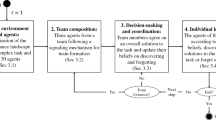Abstract
Self-organized rule-following systems are increasingly relevant objects of study in organization theory due to such systems&2018; capacity to maintain control while enabling decentralization of authority. This paper proposes a network model for such systems and examines the stability of the networks&2018; repetitive behavior. The networks examined are Ashby nets, a fundamental class of binary systems: connected aggregates of nodes that individually compute an interaction rule, a binary function of their three inputs. The nodes, which we interpret as workers in a work team, have two network inputs and one self-input. All workers in a given team follow the same interaction rule.
We operationalize the notion of stability of the team&2018;s work routine and determine stability under small perturbations for all possible rules these teams can follow. To study the organizational concomitants of stability, we characterize the rules by their memory, fluency, homogeneity, and autonomy. We relate these measures to work routine stability, and find that stability in ten member teams is enhanced by rules that have low memory, high homogeneity, and low autonomy.
Similar content being viewed by others
References
Benjaafar, S. (1994), “Models for Performance Evaluation of Flexibility in Manufacturing Systems,” International J. of Production Research, 32(3), 1383–1402.
Cohen, J. and I. Stewart (1995), The Collapse of Chaos. Penguin Books, New York.
Dooley, K. (1995), Personal communication.
Dooley, K. (1997), “A Complex Adaptive Systems Model of Organizational Change,” Nonlinear Dynamics, Psychology, and the Life Sciences, 1(1), 69–97.
Fulkerson, W. (1994), “Manufacturing Systems Optimization and Control: Adaptation and Innovation Through Artificial Life,” in Proceedings of the Chaos Network Conference, Denver.
Gelfand, A.E. and C.C. Walker (1984), Ensemble Modeling. Marcel Dekker, Inc., New York.
Holland, J. (1995), Hidden Order. Addison-Wesley, New York.
Huberman, B.A. and T. Hogg (1995), “Communities of Practice: Performance and Evolution,” Computational and Mathematical Organization Theory, 1, 73–92.
Hurd, L.P. and S. Wolfram (1986), “Table 1: Rule Forms and Equivalences,” in S. Wolfram (Ed.) Theory and Application of Cellular Automata, World Scientific Pub. Co., Singapore.
Jennergren, L.P. (1981), “Decentralization in Organizations,” in P. Nystrom and W. Starbuck (Eds.) Handbook of Organizational Design, Oxford University Press, Oxford.
Kauffman, S.A. (1969), “Metabolic Stability and Epigenesis in Randomly Constructed Genetic Nets,” Journal of Theoretical Biology, 22, 437–467.
Kauffman, S.A. (1993), The Origins of Order. Oxford University Press, Oxford.
Kauffman, S.A. (1995), At Home in the Universe. Oxford University Press, Oxford.
Langton, C. (1992), “Life at the Edge of Chaos,” in C. Langton, C. Taylor, J. Farmer, and S. Rasmussen (Eds.) Artificial Life II, Addison-Wesley.
Lawler, E. and S. Mohrman (1985), “Quality Circles after the Fad,” Harvard Business Review, 63(1), 64–71.
Lin, G.Y. and J.J. Solberg (1992), “Integrated Shop Floor Control Using Autonomous Agents,” IIE Transactions, 24, 57–71.
March, J.G. (1994), A Primer on Decision Making. Free Press, New York.
NCMS Newsletter, September 1994, Ann Arbor, Michigan.
Prigogine, I. and I. Stengers (1984), Order Out of Chaos. Bantam Books, New York.
Safizadeh, M. (1991), “The Case of Workgroups in Manufacturing Operations,” California Management Review, 33(4), 61–82.
Simon, H. (1957), Administrative Behavior. MacMillan, New York.
Smith, V. (1997), “New Forms of Work Organization,” Annual Review of Sociology, 23, 315–339.
Taplin, I. (1995), “Flexible Production, Rigid Jobs: Lessons from the Clothing Industry,” Work Occupations, 22(4), 412–438.
Uhl-Bien, M. and G. Graen (1998), “Individual Self-Management: Self-Managing Activities in Function and Cross-Functional Work Teams,” Academy of Management Journal, 41(3), 340–350.
Upton, D. (1992), “AFlexible Structure for Computer-Controlled Manufacturing Systems,” Manufacturing Review, 5(1), 58–74.
Walker, C.C. (1971), “Behavior of a Class of Complex Systems: The Effect of System Size on Terminal Cycles,” Journal of Cybernetics, 1, 55–67.
Walker, C.C. (1987), “Stability of Equilibrial States and Limit Cycles in Sparsely Connected, Structurally Complex Boolean Nets,” Complex Systems, 1, 1063–1086.
Walker, C.C. (1990), “Attractor Dominance Patterns in Sparsely Connected Boolean Nets,” Physica D, 45, 441–451.
Walker, C.C. and A.A. Aadryan (1971), “Amount of Computation Preceding Externally Detectable Steady-State Behavior in a Class of Complex Systems,” Journal of Bio-Medical Computing, 2, 85–94.
Walker, C.C. and W.R. Ashby (1966), “On Temporal Characteristics of Behavior in Certain Complex Systems,” Kybernetik, 3, 100–108.
Walker, C.C. and S.G. Motwani (1994), “Towards Inherently Useful Theory, a Management Example,” Kybernetes, 23, 23–33.
Wolfram, S. (1983), “Statistical Mechanics of Cellular Automata,” Reviews of Modern Physics, 55, 601–644.
Wolfram, S. (1986), “Approaches to Complexity Engineering,” Physica D, 22, 385–399.
Wuensche, A. (1992), The Global Dynamics of Cellular Automata. Addison-Wesley, Reading.
Author information
Authors and Affiliations
Rights and permissions
About this article
Cite this article
Walker, C.C., Dooley, K.J. The Stability of Self-Organized Rule-Following Work Teams. Computational & Mathematical Organization Theory 5, 5–30 (1999). https://doi.org/10.1023/A:1009689326098
Issue Date:
DOI: https://doi.org/10.1023/A:1009689326098




